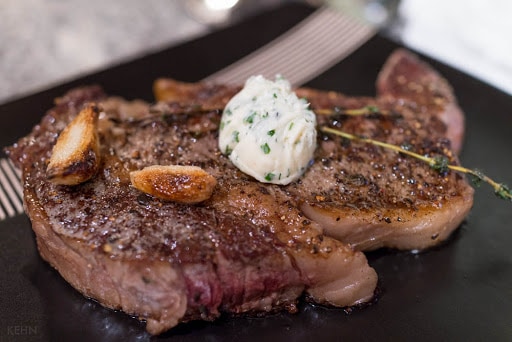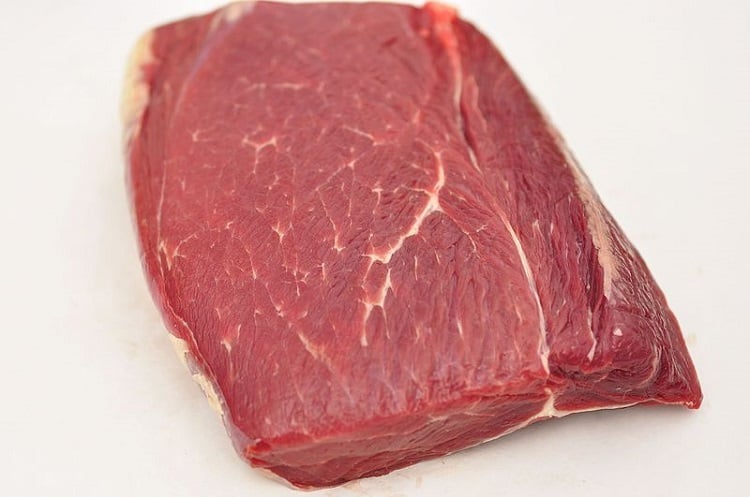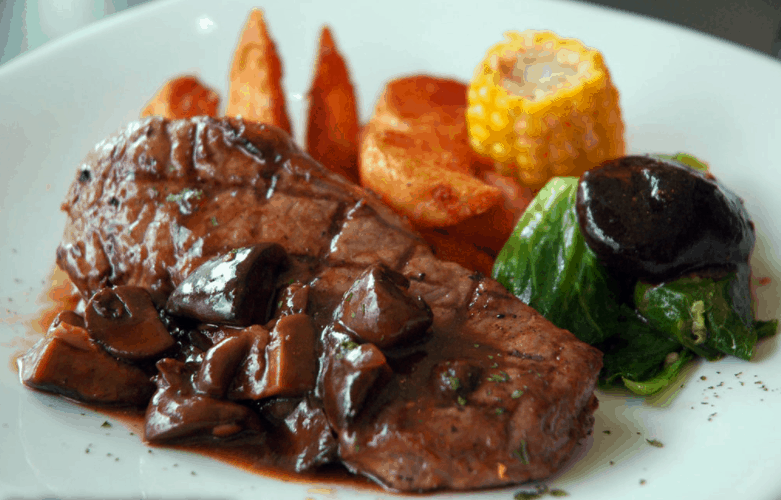- Ribeye vs Sirloin: Our Full Guide - April 7, 2022
- Traeger vs Weber Grills Brand Comparison: Choose The Best! - April 7, 2022
- Ooni Karu Review: Is It Worth It? - April 4, 2022
Sirloin and Ribeye are some of the most popular steak cuts. You may not know how to differentiate them and go for either as long as you have steak. However, there are some differences between the two. It is good to know where they come from and their differences before you can compare and determine the best steak for your needs.
Where Do Steaks Come From?

Farming cattle is a big part of the US economy. The world’s largest per-capita consumer and largest producer of beef in the United States. More than 35% of all farming in the US is beef production-based. This is the largest percentage of any US agricultural market.
There are years of effort from dedicated ranchers, breeders, and other cattle-raising professionals and experts. Over the century, major advances in our understanding of cow biology and technology have led to big changes in the cattle industry.
Pasture-raised beef, pork, lamb, and chicken delivered on your schedule, every 2, 4, or 8 weeks. Free of antibiotics, hormones, and GMOs.
Currently, beef cattle production is broken down into three main categories:
- Cow-calf operations – where cattle are birthed and bred
- Back grounding – this is where beef cattle are raised until they acquire significant mass
- Feedlot operations – the last step where cattle are fed a diet. The diet is designed to produce marbling and muscle
Difference between Bulls and Steers
A bull and steer have only one difference; a steer is a bull calf that has had its testicles removed. Steers generally become “chubbier” and have a gentler temperament than their bull brothers. Steers tend to utilize feed better and grow faster. It is the reason why farmers prefer steers to bulls.
If you are looking for a sirloin or ribeye steak that is tender, it is better to go for a steak from a steer. If you do not mind chewing on a tough piece of steak, then get one from a bull. Take note the juiciness and tenderness will also be determined by how the animal was reared.
An In-depth Look at Sirloin vs Ribeye
These are two amazing cuts of beef set apart by several features. Knowing these differences can help you understand why they are different and when is the best time to use each.
What Is Ribeye?

Just as the name suggests, ribeye is gotten from the rib primal. In most cases, it is taken from rib number six to rib number twelve. It is a favorite among steak eaters because of its health benefits. For instance, you get a healthy dose of large marbling combined with longissimus dorsi muscle in the form of a large fillet.
During cooking, the meat is kept moist thanks to the intramuscular fat used to make up the marbling. The same fat enhances the steak’s flavor. Because the longissimus dorsi muscle is rarely used when the animal is alive, it is always tender and comes with a deep beefy flavor.
The majority of ribeye steaks also have a characteristic cap of the spinalis. This is a muscle that is separated from the longissimus dorsi by a kernel of fat. Spinalis is a heavily marbled muscle. This means it can add a rich juicy and flavorful element. This element on its own would be too fatty. The leaner meat on the rest of the cut combines with the spinalis fantastically.
One of the surprising things about ribeye steak is you can decide to get a cut with or without bone. When it is with bone, it is commonly referred to as tomahawk steak or cowboy steak. The name is only used when the full length of the bone is left on. Sometimes you will find the ribeye being sold as Scotch fillet, beauty steak, Spencer, or Delmonico.
What is Sirloin Steak?
Sirloin is considered as a subprimal cut that is larger than a ribeye. Often it is separated into various other cuts that include:
- Top Sirloin
- T-bone steak
- Roasts
The most common sirloin steak cut is the top sirloin.
Sirloin steak is a leaner cut than a ribeye. It does not have the fatty and marbling cap you will find in a ribeye. As such, it is not as tender nor is it as heavily flavored. Although it is not as fatty, nor does it have connective tissue, this steak has a unique chew without being tough and it has a beefy flavor. If you prefer a deep flavor, you should look for a steak that has been dry-aged for a minimum of three weeks.
People, who are looking for a flavorsome and tender steak without high-fat content, then go for sirloin instead of ribeye. Sirloin steaks are not always named “Sirloin Steak. Other common names include a club steak, Omaha Strip, Kansas City Strip, or New York Strip.
Ribeye and Sirloin Steak Comparison
You should know calling one steak cut “better” than another is hard as it is subjective to individual preferences. If you find it hard to choose between ribeye and sirloin, some key features can make your decision-making process easier.
The areas include:
- Appearance and flavor
- Cost
- Health benefits
Appearance and Flavor
There is an interesting fact about the flavor of steaks. The depth of flavor is determined by the amount of fat it contains. Ribeye has more flavor than sirloin. It has significantly more marbling and it has a fatty spinalis cap. Both factors are responsible for increasing the depth of its flavor.
As mentioned, dry-aging is a common technique used by people who want to increase the flavor and tenderness of steaks. If you are looking for a steak with minimal fatty meat and a rich beefy taste, then a dry-aged sirloin is your best choice. If you want to age your steaks, consider using dry-aging bags during the process.
Cost
The price of a steak is influenced by several factors. They include the USDA rating (Used in the US), weight, and the animal’s breed. However, it is hard to find a place where you can get ribeye cheaper than sirloin. The extra marbling found on ribeye makes it more expensive than a sirloin steak of the same weight.
The amount of marbling is the basis for the USDA rating system. For the rating to be determined, they use the ribeye as the basis for the rating of the entire animal. Ribeye is therefore usually rated as “prime cuts”. This means they will cost more than sirloin.
Health Benefits
There are some health benefits associated with eating lean beef. If you need to cut down on your fat consumption and you do not want to give up eating steak, you are better off going with sirloin. It is significantly leaner than a ribeye. However, top sirloin steak will retain its taste and tenderness without the intense marbling you would find in ribeye.
Preparation of Sirloin vs Ribeye

From the information above, you can clearly see ribeye and sirloin are distinctly different cuts of beef. This means their preparation techniques will also vary.
Preparation and Cooking of Ribeye
If you are preparing ribeye in your home for the first time, start with a 30 oz ribeye. It is better to use this than purchasing thinner individual steaks. A note to remember is a thicker steak is easier to cook. Thin steaks have a high risk of overcooking because they cook faster.
Try and get a bone-steak ribeye steak. The bone will add flavor. During cooking, it also bastes the steak from the inside as the moisture in the bone evaporates. Also, check for the best marbling. In the center or eye of your steak, look for little white dots of fat dotting the red meat. They should be evenly distributed throughout the muscle.
Steps to Prepare Ribeye Steak at Home Using a Grill or Stove
For starters, get your ribeye out of the fridge. Let it sit on a countertop for about fifteen minutes. This is crucial regardless of the cooking technique you plan on using. Put a light coat of oil on your steak and top with your preferred seasonings. The oil will reduce the chances of your meat sticking to the pan. It also helps in seasoning.
Using a Grill
Your grill is the easiest place to use to cook your ribeye steak at home. Get your charcoal or gas grill as hot as possible. Make sure you use the appropriate gap between the grates and the heat source.
For a well-done steak, place the ribeye on the grates and cook the meat for three to three and a half minutes on one side. Turn the steak 45 degrees and continue cooking for three minutes. Flip the meat over continue cooking for four minutes. Continue turning using this process and by reducing a minute for each complete turn.
When you are cooking meat well-done, you will not need it to rest for about fifteen minutes the same way you would when cooking medium-rare. The juices of the meat will be released naturally giving you a less juicy steak.
Using a Stove
If you plan on preparing ribeye at home using a stove, you have come to the right place. You will need to use a cast-iron pan for the best results. It gives you a better crust and allows you to incorporate a basting method when you are cooking. Basting always helps improve the steaks’ flavor.
Begin by placing your cast-iron pan on the hottest and largest eye of your stovetop. Let the pan sit until it is very hot. Put your ribeye into the pan. Sear it until it begins to form a crust. Avoid lowering the heat. It should take about four minutes for the crust to form.
Flip the meat and add one spoon of butter. Add two sprigs of fresh thyme. This is a suggestion, so you can use a herb of your choice. Once added, let the meat continue to sear for approximately three minutes. The time will allow for basting using the melted butter.
Your steak is now ready for consumption. Let the steak sit for about ten minutes before you start it. The time will allow the meat to hold on to its juicers. This will in turn prevent the meat from drying out.
Sirloin Preparation and Cooking

A perfectly cooked juicy sirloin steak is something that is considered a luxury by most people. They only enjoy it in a restaurant on a special occasion, because it is an expensive choice. For you to cook a great sirloin steak, you will need the perfect recipe. Since your preference may differ from others, the following is a recipe that is known to suit the needs of most people when it comes to sirloin steaks.
Things to Consider before Cooking a Sirloin Steak
There are some things you need to consider before you think of cooking sirloin steak. For example, a steak that is at room temperature with a thickness of three to four centimeters will take about a minute and a half on each side. A few minutes in the oven will be added to cook through the middle. The trick is by avoiding overcooking and getting an exceptional sear on the outside.
The other important thing you need to remember when cooking this steak is the crucial role resting time plays. When cooking a sirloin steak, the muscle fibers need time to relax. This means you should not immediately cut the steak when it is ready.
The delicious meat juices will drain into the plate making your steak less juicy and delicious. Rest it for about five minutes. The time is sufficient for the meat to relax. When the meat relaxes it reabsorbs all those juices. The result is a juicy and tender sirloin steak.
Sirloin Sous Vide Reverse Sear
Sirloin benefits from a more delicate preparation and cooking approach thanks to its lower fat content. This does not mean you cannot cook sear it on a grill. It just means there are other better methods to cook your steak to make it the perfect medium-rare. Sous vide is one of the best ways to get the perfect medium-rare without overcooking your sirloin.
Preparation
Just like the ribeye, prepare your sirloin steak at least a day before cooking. Use the same salting and refrigeration steps you used above.
Cooking
In this case, you will need to vacuum seal your meat and cook using 130 degrees Fahrenheit using sous vide. The cooking time is a minimum of one hour, but you shouldn’t exceed four.
Remove the sirloin from the vacuum bag, cover it, and let it rest for about ten minutes. You can use this time to heat your grill or pan. Covering and leaving it will also prevent the steak from searing.
Pat your steak using paper towels and put it on your cooking surface only when your grill or pan is ripping hot. If you are using a skillet, you should add a little neutral oil. Cook for one minute on each side until the meat’s surface changes to brown and is crisp. You can serve and enjoy it immediately.
FAQs
Answer: Sirloin is the preferred choice if you are looking for a steak that is leaner, but with less flavor. If calories are not an issue, and you are looking for a favor fillet steak, ribeye is the best choice. When you make a health-based choice, go with sirloin. It has a great number of minerals, vitamins, and proteins, with much less fat and saturated fat.
Answer: If you have grilling skills, then ribeye is great on a grill. The reason you need experience grilling this steak is the fat content. It can be dangerous for people who do not have experience cooking steaks on a grill. Beginners should go for sirloin because it allows them to beautifully grill the steak without a lot of fuss.
Answer: People who are looking for a tender steak should go for a sirloin steak known as tenderloin. It is a cut of sirloin steak with the most tender beef. The combined leanness and juiciness of the steak make it a great choice for dining out or cooking at home.
Answer: Yes you can! There are several ways you can go about this. The best method is by using a cooking method that ensures rendered fat can be collected away from the steak. For example, you can broil in a pan with a rack or grill it.
Wrapping Up
Now that you have all the facts about ribeye and sirloin, you can cook the cut of your choice. Whether it is the juicy and rich ribeye or the tender and lean sirloin, the above cooking methods will allow you to get the best from both these cuts. Choose between cooking rare, medium, red, or well done.
Pasture-raised beef, pork, lamb, and chicken delivered on your schedule, every 2, 4, or 8 weeks. Free of antibiotics, hormones, and GMOs.


